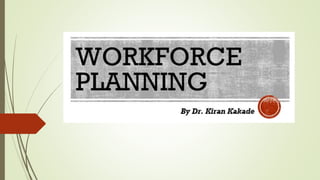
Workforce planning
- 3. What is Workforce Planning Workforce planning is the process of analyzing, forecasting and planning workforce supply and demand, assessing gaps, and determining targeted talent management interventions to ensure that an organization has the right people – with the right skills in the right places at the right time – to fulfill its mandate and strategic objectives. The Society for Human Resource Management defined workforce planning as “the strategic alignment of an organization’s human capital with its business direction” (SHRM HR Q&As, 2012).
- 4. Workforce planning is often referred to as HR planning, succession planning, human capital planning, and/or talent management
- 6. PURPOSE OF WORKFORCE PLANNING Reduce costs by helping management anticipate shortages or surpluses of human resources Provide a better basis for planning employee development that makes optimum use of workers' attitudes Improve the overall business planning process. Provide more opportunities for women and minority groups in the future growth and strategic plans of the organization. Promote greater awareness of the importance of sound human resources throughout all levels of the organization. Provide a tool for evaluating the influence of various HR actions and policies.
- 7. • Identifies skills that the organization doesn't currently have, but will soon require Thus, workforce planning ………. • Identifies the gaps between the future needs of the organization and the structure of the current organization, and
- 9. Why do Workforce Planning When properly implemented, workforce planning ensures an organization has the right people with the right skills in the right places at the right time. These factors, people, skills, positions, and timing, need to be aligned to ensure your organization is able to continue to meet its mission.
- 10. THE NEED FOR ADDITIONAL LABOR Workforce planning helps ensure that organizations fulfill their business plans for the future in terms of financial objectives, output goals, product mix, technologies and resource requirements. Once business plans are determined, the HR planner assists in developing workable organizational structures and in determining the number and types of employees that will be required to meet those plans.
- 11. ALIGNMENT BETWEEN BUSINESS AND HUMAN RESOURCE PLANNING The size of an organization’s workforce, should be based on its business plans. Every organization should ask the question, “How many of which types of employees will be required to achieve our organizational goals?” To reach its goals, an organization must have the proper mix of employees with the necessary knowledge, skills, and abilities. Therefore, three levels of human resource planning need to occur, Long-Range Planning (10 Years) Middle-Range Planning (5 Years) Short-Range Planning (1 to 2 Years)
- 13. WORKFORCE PLANNING AND HR ACTIVITIES Workforce planning is important because it influences almost all other HR activities, including job analysis, recruitment and selection, training and development, and career management. We will now discuss the relationship between workforce planning and each of these functions. Job Analysis Recruitment and Selection Training and Development Career Management
- 14. TECHNOLOGY AND WORKFORCE PLANNING As new technologies such as state-of-the-art information systems, robots, and office automation are introduced into the workplace, workforce planning will be used to answer questions such as the following: How can organizations assimilate technology into the workplace? What impact do these new technologies have on job design? Which skills are needed by the firm? Workforce planning is also concerned with the challenges of the aging workforce, unemployment, and the economic impact of shifting from a manufacturing to a service economy. Through human resource information systems (HRIS) , organizations can easily access employee job preferences, work experiences, job histories, and performance evaluations.
- 16. What are the benefits of Workforce Planning As you develop your business case for workforce planning, it is important to discuss the tangible benefits workforce planning can have on your organization to engage business leaders and emphasize the value of this effort. When properly implemented, workforce planning can: Identify staffing levels and competencies required to support both short- and long-term strategies and goals to minimize the chance of workforce misalignment. Address gaps between the current and desired future workforce and defines these talent surpluses and shortages. Align the workforce with business plans to appropriately target and prioritize skill requirements and transition strategies. Support organizational change efforts and create a roadmap to achieve an ideal future workforce.
- 17. Strategic Workforce planning is composed of six phases: 1.Strategic Direction 2.Supply Analysis 3.Demand Analysis 4.Gap Analysis 5.Solution Implementation 6.Monitoring Progress
- 19. Not sure where to begin with workforce planning? There are two common paths when getting started: Path 1: Unidentified Needs Path 2: Needs Known
- 20. Path 1: Unidentified Needs Workforce planning needs are not currently defined or identified by a leader or sponsor. Try these four steps to identify what workforce planning activities 1. Identify the Workforce Planning Sponsor(s), and Customer(s), and Prepare for a meeting to discuss priorities and needs. 2. Conduct a Workforce Planning Assessment 3. Create the Business Case for Workforce Planning for your specific project 4. Create a Strategic Workforce Plan
- 21. What Next………. Talent Acquisition